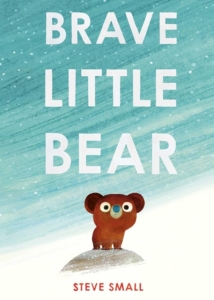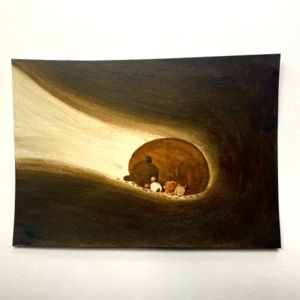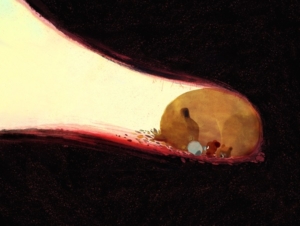
This article is in the Windows into Illustration Category
Windows into Illustration: Steve Small
Steve Small was shortlisted for the Klaus Flugge Prize for most exciting newcomer to picture book illustration for his book I’m Sticking with You, written by Smriti Halls and published in 2020. Since then he has written and illustrated The Duck Who Didn’t Like Water, Wellington’s Big Day Out, and now Brave Little Bear. All are full of pace and movement, characters perfectly defined, with a wealth of deadpan humour to enjoy. Here he talks about the creative process that produced Brave Little Bear.
 Brave Little Bear is a simple story about how a small bear family faces change. Arlo and Eva are siblings who, only knowing the safety of their winter den and their immediate surroundings, leave their home with their mother to travel across the mountain to a lowland valley for the approaching Spring. Each bear faces the prospect of change, and the story focuses on Arlo who is the most fearful of change and the journey ahead.
Brave Little Bear is a simple story about how a small bear family faces change. Arlo and Eva are siblings who, only knowing the safety of their winter den and their immediate surroundings, leave their home with their mother to travel across the mountain to a lowland valley for the approaching Spring. Each bear faces the prospect of change, and the story focuses on Arlo who is the most fearful of change and the journey ahead.
After I had written the text of Brave Little Bear, I spent a while drawing the characters and thinking more closely about the tone of the illustrations.
Though I favoured a naturalistic illustration style for this book, I still prefer to make simple images that set out to capture emotional qualities of the story rather than the detail. I particularly wanted the first image in the story to communicate how Arlo loved being curled up with his Mum and sister in his warm and familiar den. I knew it had to be a dark image because the rest of the book takes place in the outdoors where everything is in daylight and in the open, and not hidden from view. It is this lack of barriers between himself and ‘new’ things that makes Arlo feel afraid.
I work in watercolour, and after a final pencil sketch, I paint all the elements of the illustration separately on layers of paper which I scan into  my computer and compose digitally. It gives me all the accidents of paint and real mark-making that I enjoy and allows me to colour and fine tune the composition freely whilst meeting my deadlines.
my computer and compose digitally. It gives me all the accidents of paint and real mark-making that I enjoy and allows me to colour and fine tune the composition freely whilst meeting my deadlines.
After a warm-up watercolour sketch, I went straight into painting, and rather than creating a dimensional space for the den, I made several watercolour washes that layered in the rocks and earth in an abstract manner, communicating the feeling of being enclosed, rather than painting the den itself. I approached the bears more traditionally. Since it was the first time the reader would see the three bears, I needed to make sure they were easily discernible.
 Whenever you work in this kind of abstract way, it leaves more room for interpretation. I showed the final illustration to someone, and they said it felt like bears sleeping in a meteor soaring through the night sky. I hadn’t expected that reading but they were right. Seen in a certain way, it did look like that, and the more I thought about it, the more I enjoyed the metaphor it offered for Arlo’s emotional experience: encased in rock, warm, and safe, soaring past each new experience, uninterrupted.
Whenever you work in this kind of abstract way, it leaves more room for interpretation. I showed the final illustration to someone, and they said it felt like bears sleeping in a meteor soaring through the night sky. I hadn’t expected that reading but they were right. Seen in a certain way, it did look like that, and the more I thought about it, the more I enjoyed the metaphor it offered for Arlo’s emotional experience: encased in rock, warm, and safe, soaring past each new experience, uninterrupted.
I hope it also looks like three bears in a den.
Brave Little Bear is published by Simon and Schuster, 978-1471192418





